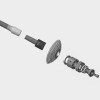Sarcoma diagnosis
- Home
- Sarcomas surgery
- Sarcoma diagnosis
SARCOMA DIAGNOSIS: CLINICAL, IMAGING AND BIOPSY
CLINICAL
We must suspect the presence of a sarcoma when we are faced with any lump that:
- Has grown considerably during the last months
- Measures more than three cms
- It is of deep location
- Produces pain
IMAGING
- Simple radiology: n the case of bone tumours it is still the most important test today.
- Ultrasound: In soft tissue tumours it helps to define the size and depth, as well as the solid or cystic nature of the tumour.
- Magnetic Resonance Imaging (MRI): This is the most important test. It helps to find the exact location of the tumour (if it is deep, if it is next to important vascular structures, if it affects more than one compartment, etc.). It is usually done with contrast. When the tumour captures contrast it is suspected of being malignant.
BIOPSY
It represents perhaps the most important step in diagnosis and will condition treatment in the future.
No soft tissue masses suspected of sarcoma should be operated on without a prior biopsy.
The biopsy should be performed only by an expert radiologist in contact with the surgeon, or by the surgeon who will be performing the surgery.
Usually, the biopsy is performed by Trucut, which is a fine needle through which a small amount of material is removed and can be analized by the pathologist. This material is taken in such a way that it does not contaminate the surgical site on which the definitive intervention will be performed later.
An improperly performed biopsy can permanently compromise the success of future surgery. Sometimes a poorly performed biopsy determines amputation as the only treatment option.
![]() Biopsy and treatment principles
Biopsy and treatment principles
Contact Dr. Oscar Tendero in Mallorca specialitst in sarcoma surgery.
YOUR HEALTH FIRST

GEIS bone tumor meeting

Endo-exo integrated femoral prosthesis
CONSULT
Hospital Juaneda Miramar
Camí de la Vileta, 30
07011 Palma
971 280 000


